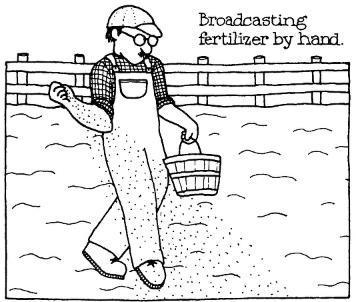Potatoes wi ll grow in just about any well-drained soil, but they dislike soggy soil. Because they do all their growing underground, they can expand more easily in loose, loamy soil than in heavy, compacted, clay soil that keeps plant roots from getting the air and water they need.
ll grow in just about any well-drained soil, but they dislike soggy soil. Because they do all their growing underground, they can expand more easily in loose, loamy soil than in heavy, compacted, clay soil that keeps plant roots from getting the air and water they need.
Heavy soils can dampen your potato-growing enthusiasm, but if you add organic matter (leaves, hay, peat-moss) to the soil, especially at planting time, you'll be able to ease the hardship of tough earth. When worked into heavy soils with a shovel and rake or tiller, organic matter wedges itself between the tiny soil particles. It works to open up the soil, letting air and water circulate. If you have light, sandy soil that can't hold water, organic matter also works to help the soil hold moisture better.
Work organic matter into the soil whenever you don't have a crop growing: before the season gets underway, between crops, or after the harvest. Stockpile compost, leaves and grass clippings for these opportunities.
Using Cover CropsAnother good way to build up organic matter in the soil is to grow "green manure" or "cover" crops to till right back into the soil. Sow quick-growing annual ryegrass, for example, in late summer after harvesting your crops. Then work the crop residues into the soil, sow the annual ryegrass and let it grow until cold temperatures kill it. By planting time the next spring when you're ready to till the ryegrass into the soil, it will have decomposed well enough to supply your crops with moisture-holding organic matter and the nutrients they need.
If you can't grow a cover crop, try to spread four or five bushels of compost onto each 100 square feet of potato growing area, and work it into the soil before planting.
Gardeners with clay soil can also incorporate lots of organic matter into the rows where they plant. Covering the seed pieces at planting time with leaves mixed with soil, for example, gives the plants the breathing room they need but couldn't get if planted in plain soil.
 Victory Seed Company has all the seeds you want for your best garden in 2024.
Victory Seed Company has all the seeds you want for your best garden in 2024.
For 25 years, the family-owned Victory Seed Company has provided the highest quality vegetable, herb and flower seeds to families across the country. We are passionate about providing you the best seeds available that give excellent germination, robust plants, and the harvest you want. With a catalog of over a thousand varieties, we have everything, and our prices are the kinds that we'd want to pay. We have hundreds of yesterday's heirloom vegetables, as well as today's award winning hybrid selections. Get to know us by visiting our website and browsing through our online vegetable seed catalog.
| 1. Getting Started With Potatoes |
| 2. A Brief History of the Potato |
| 3. How Potatoes Grow |
| 4. Irish Potato Varieties |
| 5. Potato Rotations and pH |
| 6. Soil Preparation for Potatoes ← you're on this article right now |
| 7. Sweet Potato Basics |
| 8. Sweet Potato Varieties |
| 9. Potato Essentials |
| 10. Sweet Potato Essentials |
| 1. Getting Started With Potatoes |
| 2. A Brief History of the Potato |
| 3. How Potatoes Grow |
| 4. Irish Potato Varieties |
| 5. Potato Rotations and pH |
| 6. Soil Preparation for Potatoes ← you're on this article right now |
| 7. Sweet Potato Basics |
| 8. Sweet Potato Varieties |
| 9. Potato Essentials |
| 10. Sweet Potato Essentials |